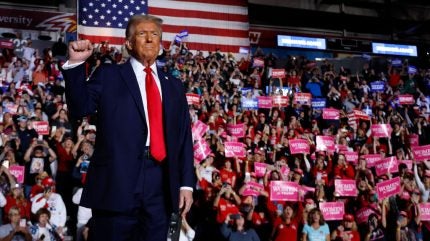
With the popular vote and the electoral college in hand, Donald Trump has once again been elected president of the US. What many expected to be an election that would be won by a razor-thin margin has turned out to be a major sweep for Republicans. Trump has discussed his economic plans for his second term widely, albeit through varying iterations and levels of clarity. Now that there is certainty about who will occupy the White House for the next four years, what will Trump mean for foreign investment?
Thys Louw, emerging market fixed income portfolio manager at investment manager Ninety One, said: “The initial market reaction [to Trump’s win] reveals the expected policy mix to comprise more expansionary US fiscal policy, reduced government regulation, a change in geopolitical stance, and increasingly aggressive trade policy towards global manufacturing centres such as Europe and Asia.

Discover B2B Marketing That Performs
Combine business intelligence and editorial excellence to reach engaged professionals across 36 leading media platforms.
“This has been reflected in the market trading with a reflationary/risk-on tone in US assets (higher treasury yields, stronger equity futures and a stronger dollar) while currencies such as the euro and Mexican peso have been the main underperformers as they are likely to find themselves in the crosshairs of trade policy.”
Trump has said that raising import tariffs across the board – 60% for China and 10% for all other countries – will be a net positive for the US. He says it will incentivise foreign companies to build manufacturing plants in the country, which would mean a surge in foreign direct investment (FDI). At the same time, he would extend the Tax Cuts & Jobs Act he passed in 2017, which saw him lower corporate income tax from 35% to 21%.
Alicia Garcia-Herrero, chief economist for Asia-Pacific at Natixis, explains that “Biden has attracted huge amounts of investment into the US […] but I think that Trump will attract even more because corporate taxes are going to be lower, just like in his first mandate. There is also going to be a huge amount of repatriated profits into the US from American companies because of tariffs.”
Many experts have pointed out that this plan assumes that the US’ trading partners, rather than increase investment within US borders, might also simply retaliate with tariffs of their own. It puts into focus the dilemma that many countries will face; to acquiesce, or to leverage what trade power they have against new tariffs.

US Tariffs are shifting - will you react or anticipate?
Don’t let policy changes catch you off guard. Stay proactive with real-time data and expert analysis.
By GlobalDataHerrero expects there to be less US FDI into Mexico as Trump “threatened, at the very last moment in the campaign, to impose 100% tariffs on Mexico, and maybe not to renew the US-Mexico-Canada Agreement”, which was the free trade agreement that replaced NAFTA. Mexico’s economy will “suffer” as a result.
She added that Trump “will make a deal, like the Phase One deal. That one was $600bn of Chinese imports from the US, and this one will be a much, much bigger deal. China will have to pay a high price to avoid pressure tariffs.” The big question in terms of trade with China, Herrero highlights, is whether Taiwan will be part of any deal, “meaning whether Trump will soften the position that Biden maintained on Taiwan in exchange for more exports or investments into China”.
ING economists predict that the earliest these tariffs might be put in place is in late 2025 and that there “will be a phased introduction given the potential for significant economic disruption”. They add that China would likely be the first to feel the effects, with other countries following later.
This has alarmed major European allies facing sluggish growth, such as Germany and the UK. The National Institute of Economic and Social Research, a London-based think tank, has warned that UK growth could half if Trump goes through with his tariff plan. German automakers, who are already facing an industry-wide crisis, might also be in danger as Trump recently told supporters: “I want German car companies to become American car companies.”
Even if the tariffs push foreign companies into sourcing products within US borders, the shift could take years and drive inflation for US consumers in the meantime.
Another central prong to Trump’s plan is his aggressive immigration policy, where he promises to deport ten million undocumented people and restrict the entry of more. This will have major effects on the US’s capacity for growth, as undocumented workers are an important economic force in the country. Cutting off a source of qualified workers while the numbers of American-born workers decrease, will make growth harder to realize.
Steven Blitz, chief US economist for macroeconomic forecasting consultancy TS Lombard, says that Trump’s win coupled with a working majority in the Senate will mean that “the rules that impact business investment by US firms elsewhere in the world will most assuredly bend to Trump’s wishes– a redirection into the US.”
“He is laser focused to redirect capital investment into the US. He is also more than accepting of foreign investment in the US, think in terms of Japanese car companies being cajoled into opening assembly plants in the US beginning in the late 1980s. The move has been a success story — these operations are now firmly embedded in the US economy with design offices and supply chains for assembly.”
“The reshaping of tax and regulatory policy so that firms invest in the US, be they foreign or domestic based, is necessary but not sufficient. There are other factors, such as tariffs, the currency, inflation, interest rates, and uncertainty about growth, to consider. But, in the assumption that all else is equal, I would expect US firms to shift, on the margin at least, the direction of their capital investments to the US.”





